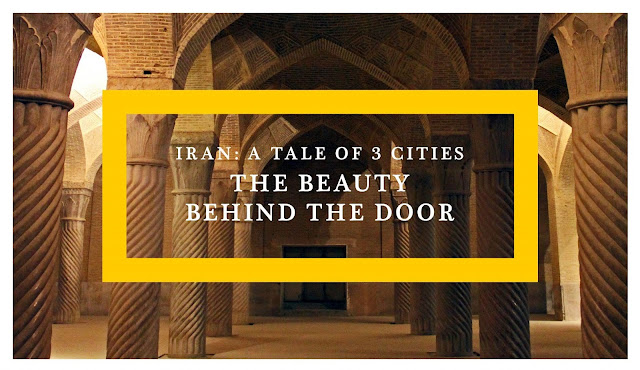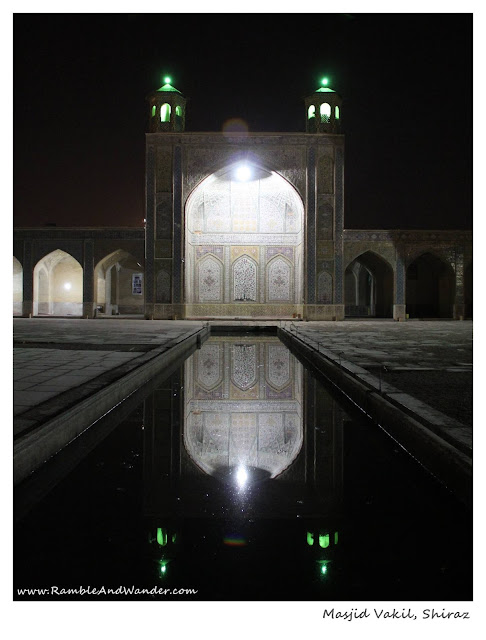 |
The good folks at Vakil Bazaar were starting to close their stalls for the night so I thought it’s time for me to go back to the hotel. I needed to pack my stuff anyway, as I was leaving Shiraz, and Iran, the next day.
I walked out of the bazaar through one of its main side doors that led to an open space, which was a car park and carpet market earlier during the day. To my left, there’s a high wall which, I thought, is part of the bazaar. I was wrong though, because just a few steps away from the exit, there’s a beautifully tiled arch that frames the doors to whatever is behind the high wall.
I walked out of the bazaar through one of its main side doors that led to an open space, which was a car park and carpet market earlier during the day. To my left, there’s a high wall which, I thought, is part of the bazaar. I was wrong though, because just a few steps away from the exit, there’s a beautifully tiled arch that frames the doors to whatever is behind the high wall.
 |
(Above) The tile work on the “arch” of the entrance gate; and (Below) one side of the entrance gate. |
 |
The doors were slightly ajar but I couldn’t see much of what’s behind them. I was curious though, as the arch and the tiles look like an entrance to a mosque, or maybe a tomb. I took a peek and pushed the door open, thinking that if it’s a mosque, the worst thing that could happen is that I get told that it’s closed for the night. On the other hand, if it’s a private property…
Right behind the doors, I found myself in a “landing” area that leads to a corridor on the left-hand side. I walked towards it and suddenly found myself in a very large open courtyard.
Yup, it’s a mosque all right. A very beautiful one.
 |
(I later found out that it’s called Masjid Vakil (Vakil Mosque); built in the mid-18th century during the lifetime of Karim Khan, founder of Zand Dynasty. He used the title “Vakil” or “representative” and had been described as one of the most just rulers in Iranian history.)
In the middle of the courtyard, there is a long, shallow, rectangular pool that directs your eyes towards a small covered area, called shabestan (night prayer hall), on the other side of the courtyard.
 |
View of the main iwan, reflected in the shallow pool, that runs across the courtyard.
|
 |
View of the minbar (pulpit) with its 14-step staircase that is made of and cut from a solid marble block. |
 |
The intricate tile work on the concave of the main iwan. |
The open hall is covered by beautiful cupolas and arches resting on about 50 carved stone columns. Some areas of this hall are covered in gloriously beautiful tile work while some other areas are just plain tile-less, but no less soothingly beautiful.
The overall effect is really quite something.
 |
 |
 |
 |
 |
 |
The second iwan at the back of the masjid, as viewed from across the courtyard. |
 |
The concave of the second iwan. |
 |
There was no one around but I could hear the evening prayer being conducted in a room located somewhere to the far left of the courtyard, probably sandwiched between the courtyard and the bazaar. Listening to the verses of the Quran being recited by the imam while standing here alone in the hall among the many columns made me appreciate their beauty even more.
Imagine the masjid and its courtyard being full with the faithful on a Friday noon, listening to a sermon being delivered by an imam standing on the marble minbar... That would have been a truly beautiful and unforgettable experience.
I might not have the chance to experience that – it’s my last full day in Shiraz after all – but I’m still glad, and thoroughly grateful, that I had followed my instinct, pushed open the door and found this beauty.


cantiknya gambarnya! simetri dia begitu tepat skali! saudara ni pakar matematik? atau pakar geometri? nnt amek gmbr sy pulak! hahah
ReplyDeleteGambar tak berapa cantik kalau dibandingkan dgn pandangan sebenar di depan mata. Macam org putih cakap, they don't do justice to the place. Saya bukan pakar apa2. Pakar berjalan pun bukan. Cuma suka berjalan.(Jwpn utk soalan2 CSI ;-))
DeleteJohn: How come i couldn't find any free WIFI there, and u're forever online? Jealous betol!!!
DeleteRBA: Cantik...cantik.. memang pakar matematik! U keep mentioning the word 'iwan'? What is 'iwan' by the way?
Pakar matematik ke? Kalau cikgu2 matematik saya baca ni, mesti dia gelak ;-S
DeleteMore info on iwan can be found here, by the way:
http://en.wikipedia.org/wiki/Iwan
Ohh..it's a hall...arabic ya..
DeleteYup, I think "dewan" was derived from that word. But iwan is a hall with wall on its 3 sides while the 4th side is open with some arch- or gateway-lookalike, whereas dewan can just be a simple hall.
DeleteIran... yang saya tahu melalui google hanya tentang hukuman gantung di kalayak ramai tu aje... apa pun negara ini masih dikira selamat untuk kita kunjungi kan???
ReplyDeleteDaripada segi keselamatan diri, insyaAllah tak ada masalah. Berdasarkan pengalaman sendiri, rakyat Iran antara orang yang paling peramah di antara rakyat negara2 yg pernah saya lawati :-)
Deletenoticed that your pics alway taken at night? lepas solat isyaq ke? anyway, putting iran in must visit ctry becos of you. dpt commission dr iran tourism board ke? hehehehe.. catch up with you another time.
ReplyDeleteAh-ha! It's because I was there during winter so daylight hours were relatively short. But yes, I do prefer to take photos in the evening when every place of interest is all beautifully lit-up :-) And of course, that's also when there are not that many tourists around, haha! ;-)
DeleteRe: Visit Iran. Yes, you really should. I bet everyone you know who has been to Iran would highly recommend the country ;-)
cantiknyaa.... diorang mmg pakar pasang tile eh?
ReplyDeletesiti rozina
Memang lawa & very detailed. Rasanya memang specialty dan trademark Iran dlm bab2 menggunakan tile di bangunan ni. Di Dubai pun, hospital Iran dan masjid Iran, semuanya menggunakan tile. Jadi bila jalan2 kat sinipun dan ternampak bangunan yg penuh tile yg base colour dia biru, terus boleh tahu yg bangunan tu ada kaitan dgn Iran.
DeleteYou should compile all these photos and produce a book perhaps call it 'Mosques of the world'. I can't recall this sort of book being published before.
ReplyDeleteHi there, Fie! Perhaps I should ;-) Thanks for the vote of confidence :-)
DeleteWhen I read your blog just like I read my book "Seni Islam" by Dr D'Zul Haimi bin Hj Md Zain but in new style with more interesting story & good photos. I think if you write the blog earlier so maybe subject History of Islamic Art and Design I was taken in 2008 out with better result.
ReplyDeleteAnyway the book is good for reference & memberikan inspirasi untuk saya mendalami seni Islam.
Saya tertanya2 kenapa masjid ini hampir sama dengan Masjid-i-Jamii, Isfahan yang saya lihat di dalam buku tersebut dan adakah ianya berkonsepkan masjid terbuka?
ArtandSoul.Art
Yes, it has a similar concept, i.e. a masjid with an open courtyard, to the one in Esfahan. The designs however are different. This one doesn't have any dome.
DeleteAlhamdulillah, Allah pilih saudara berkunjung dari masjid ke masjid serata dunia... bestkan! Usaha saudara mengadakan blog sebaik ini mengingatkan pembaca akan kebesaran Allah... Tahniah!
DeleteArtandsoul Art
cantikk :)
ReplyDeleteand so different from Malaysia's concept, i guess ?
Hi, Yaya! Yes, beautiful, isn't it? In Malaysia, I'm not too sure but Masjid Putra in Putrajaya does have a small courtyard concept too. And the bridge near to Masjid Putra was inspired by one of the bridges in Esfahan, if I'm not mistaken. You can check them out in one of my blog posts on Putrajaya as well as on Bridges of Esfahan :-)
DeleteImpressive tiles work. I believe Persian arts/architecture is one of the best in the world. Now I know why Shah Jahan was inspired by Persian architecture to build the majestic Taj Mahal ;p
ReplyDeleteYup, very impressive indeed, especially knowing that it's actually built more than a century ago, without any modern day tools, e.g. computer, etc. ;-) Hmm... Interesting to know that Shah Jahan was inspired by Persian architecture because Taj Mahal is all marbles, I think? Or it has tiles on the inside? I don't know, I didn't go inside Taj Mahal when I was there last year. The queue was too long, haha!
DeleteYes, it was all marbles inlay with colorful stones inside out kt Taj Mahal tu.. but i think the design of the bunga2/pattern quite similar from the Parsian & also the architecture itself.. do u that the architect who designed Taj Mahal was actually from Iran? ;p
Delete